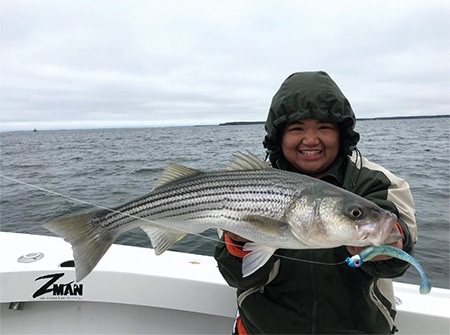Middle Bay
The Bay Bridge continues to attract anglers to fish for the striped bass that are holding near the bases of the deep-water piers. Jigging is the most common way to fish for striped bass, but some anglers are drifting with live eels, pulling them back to the pier bases with good results. The rock piles are holding striped bass, but schools of large white perch also tend to hold there this time of the year. Anglers are also having success trolling tandem or single rigged bucktails along the sewer pipe on the northeast side of the bridge.
Some of the best fishing for striped bass in the middle Bay is occurring in the area from Thomas Point to Chesapeake Beach on the western side of the Bay, and the area from Eastern Bay out past Buoy 83 and south to the False Channel at the mouth of the Choptank River. The striped bass are feeding on juvenile menhaden for the most part, although young of the year hickory shad are moving out of the Choptank and will have to pass through the gauntlet of hungry striped bass stationed at the mouth of the river.
There is still occasional bird action to direct anglers to striped bass feeding on schools of bait, but much of the action is now occurring deep, making depth finders a valuable tool this time of the year. Jigging with soft plastic or metal jigs is a productive and fun light-tackle way to catch striped bass.
Trolling is a good bet along channel edges, using tandem or single rigged bucktails in white with twistertails or sassy shads pulled behind inline weights. Umbrella rigs in white and pulled behind heavy inline weights are also working well when allowed to get down to where striped bass are suspended close to the bottom of channel edges.
Colder water temperatures are beginning to force striped bass that have been prowling the shallower waters of the Bay shores and lower sections of the tidal rivers to head for deeper water.
White perch have moved out to the deeper waters near the mouths of the major tidal rivers, the rock piles at the Bay Bridge and the deeper channel areas off Matapeake. Bottom rigs with hooks baited with pieces of bloodworm or dropper rigs rigged with small flies are the best way to reach them in the deeper waters.
Lower Bay
The lower Potomac River continues to be a major draw for anglers, spurred by a two-fish minimum at 20 inches or more, and excellent fishing. The striped bass are spread from the Route 301 Bridge south to Point Lookout. The steep channel edges offer excellent opportunities for jigging and trolling.
The lower Patuxent River is also offering good striped bass fishing out to Cedar Point. Channel edges in the 30-foot range off Cove Point, and on the eastern side of the Bay, the area from the HS Buoy south is also holding striped bass. The channels in Tangier Sound are also holding striped bass. As water temperatures decline, striped bass will be found in even deeper waters in the channels.
Jigging is always a fun light-tackle way to fish for striped bass in the fall and once fish are located, the action can be exciting. Soft plastics in the six-inch and larger size range tend to be the most popular, in shades of pearl and white. Braided line, fluorocarbon leaders, and fast action rods help make jigging more productive in the deeper waters.
Trolling is a good option to get down where the striped bass are suspended close to the bottom in the deeper channel areas. Heavy inline weights are often needed to get umbrella rigs to the depths where the striped bass are holding. White teasers and trailers are popular in the clearer waters this week. Tandem rigged bucktails dressed with sassy shads are also a good option but will also need inline weights to get them down. Using braided lines can reduce drag or water resistance when trolling.
Call Capt. Pete Wallace if you want to experience the legendary waterfowl hunting of Virginia’s eastern shore. Wallace has dozens of blinds ready for your party and you can target puddle ducks, diving ducks and geese. After the hunt, it’s time to enjoy the equally famous Chincoteague oysters!



